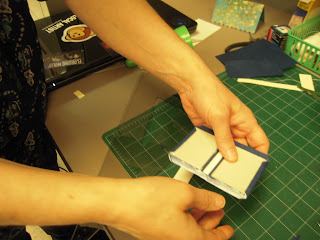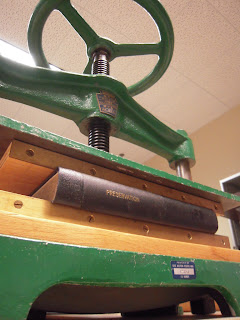This one is Quinn's octavo.
-Take the book out of the press and prepare tin metal sheets to go between the endsheets as well as old and new wax paper. The metal tins help with the bounciness of the paper (when a book naturally fans open).
-The first book I sewed the endsheet to the text block, so this is merely a matter of applying a light coat of wheat paste to the end sheets, with ample amounts in the gutter. The wheat paste should appear shiny and have no lumps.
-Close the book by pushing the cover over and then down. This stick the cover into its normal resting place.
-Change out the old wax paper for a new sheet.
-Put the item in the press with the boards around it overnight. (I will have to take this book home and apply weight to it with boards around it on my own.
*Don't worry about excess wheat paste, it comes off of leather easily.
*If the end sheet sticks out too far, it can be trimmed after it is dry.
For the second book I had to first tip on the end sheet with PVA glue, then used the same method as described above.
I was still a little confused on how to take out and put back in the reels of a VHS, so I had Sharlane show me how that was done. She showed me again the little tabs and then showed me the little runners that the film fits between. This is not something that can easily explained, so here are some images showing how each side of the film goes through the runners directly adjacent to the tape, then weaves around a runner (or wheels) that positions the film to the outside edge of the case-directly under the flap.
I finished the tiny book by making a small case for it and tipping on the endsheets using the same methods as the modern book without the creation of a mull.
For lunch we had a pizza party to celebrate our last day at Kelvin Smith Library's preservation department. Sharlane invited other departments to come down after lunch for cookies and to see our finished work. Many people stopped in to say hello while we worked on opening our book pages with a paper knife. The flat side is used by placing near the edge of the crease and doing little tears along the edge. It is best to go through one page at a time when cutting open an octavo. When you are done, it should appear that all edges of the book are deckled.
After opening our pages we tried marbling paper with ink and acrylic paints (I brought oil, but forgot turpentine-which shouldn't be used in the preservation department anyway). We researched how to make the marbled paper online and found that for every 8 cups of water, 1/2 cup of methyl cellulose should be mixed into a shallow basin. This solution should be stirred or whisked periodically over an hours time. After several attempts, we discovered that the acrylic paint would not cling to the surface correctly. The ink worked, except that it didn't stand out enough, so many of the pages looked faded when we were done. Here is our "successful" pieces:
Before we left, I photographed the book I had to leave behind in detail, along with all of the other books that were created during the semester with their creators:
I left the library for the last time at 4:30pm.































































